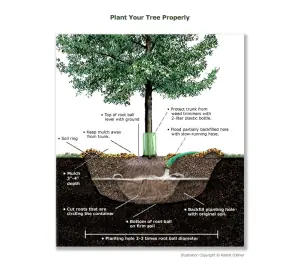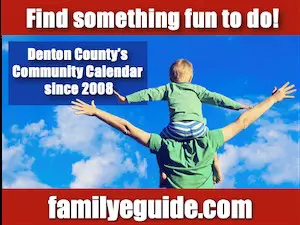
Illustration courtesy of the Texas Forest Service
By Pat Moyer, Denton County Master Gardener Association
I usually start most of the talks I do about trees with the old joke: “When is the best time to plant a tree?” with the answer, of course, being “30 years ago”. That points out the fact that trees are most appreciated as they achieve their mature size. So, without a handy time machine now is the time to start planning for trees to enhance your future landscape.
Before you run down to the store and buy the biggest tree possible, take some time and create a planning strategy that will give a new tree (or trees) the opportunity to be the highlight of your landscape.
Site Planning
Proper Site Planning will not only help you determine where planting a tree is advisable but also what type or species of tree will work best for you.
Assuming you know your soil conditions, one of the first things to do is determine what you want your tree to do. There are several reasons for planting trees. Providing a screen or shade are two of the more common reasons. Be sure to note if there are power lines nearby; a smaller tree is needed in those locations.
I enthusiastically recommend using the “Texas Tree Planting Guide” on the Agrilife website at http://texastreeplanting.tamu.edu/. That site has two very informative links. These are the “Custom Tree Selector” and the “Tree Planting and Care” links (I really don’t find the “Express Tree Selector” link very useful).
The “Tree Planting and Care” link on that site will take you to another set of links on various considerations prior to tree selection as well as some basic tree planting and maintenance recommendations. Note that each of the links also has accompanying video that helps clarify topic.
Tree Species Selection
Once you know the characteristics of the tree you want, it’s time to look at various species that meet those criteria. The most convenient place to find those is on the same Agrilife website, http://texastreeplanting.tamu.edu/. This time, use the “Custom Tree Selector” link.
That website has an extensive listing of trees by size, foliage, required soil conditions as well as native selections. (I always recommend native species over non-natives because native plants thrive under our local environmental variations, require less water and provide vital habitat for birds and other wildlife benefits.) The only required field on this website is the county. So, if, for example, you want to peruse all the trees recommended for Denton County, just select “Denton” on the County Dropdown Menu and press the “Show Trees” tab and “Voila!” there’s your Agrilife recommended list.
Each species has a link that gives additional info for that type of tree. This info cites both the good and some of the not so good aspects of the tree. Make sure you review this info before deciding on a specific species.
Picking a Tree at the Nursery
Now the fun of hunting for your ideal tree begins. Depending on the species you want, “good” trees are available from numerous sources, including Big Box stores, if you take the time to evaluate them. Once again, the Agrilife website several good tips at http://texastreeplanting.tamu.edu/PickTreeAtNursery.html . The accompanying video is also a good reference. Keep in mind pulling a tree out of its pot to check the condition is very important. If a retailer doesn’t want you to pull the plant out of its container or the tree has severely girdled roots, don’t buy that tree.
Also remember that there is usually less transplant shock to a smaller caliper (aka diameter) tree than a larger caliper tree of the same species. This means that, generally, a smaller caliper tree may start regrowth after planting more quickly than a larger caliper tree and may, in fact, overtake the growth of the larger tree.
If you’re looking at buying a really large tree, over 15-20 gallon pots, you may want to have the nursery plant it for you. In that case you may want to make sure you note an identifying characteristic (or even a photo) of the tree so you can make sure the tree that is delivered is the one you selected.
Planting the Tree
Returning, once again to the Agrilife website, at http://texastreeplanting.tamu.edu/PlantTreeProperly.html, there are several points to remember when planting the tree.
- The hole depth and width are important to establish the tree properly.
- Refilling the hole with the same soil that was removed also helps establish the tree.
- Using some form of trunk protector (they suggest using a liter plastic bottle) pays off, particularly when there are weedeaters nearby.
- Mulch retains moisture and slows weed development around the tree.
- Most important is proper watering. Watering of 6-8 gallons per inch of diameter is necessary at least once a week. In hot, dry periods this may increase to 2-3 times per week.
- Staking should only be done if necessary. Allowing the tree to develop without external support strengthens the tree.
- Trimming during the first year of a newly planted tree should be limited to removal of dead or broken limbs.
- While nurseries will plant trees all year round (particularly potted trees), planting should be done when the tree is dormant (late Fall through early Spring).
- Some trees with thin barks (red oaks for example) may need to be wrapped to prevent scalding of the bark.
Result: Right Tree in the Right Place and more
Following the guidelines above will enable you to say you not only planted the “right tree in the right place,” but 30 years from now you can also say you planted it at the right time.




















